The Science of Star Wars
On Sunday, The Horror Film Buff arranged for a group of people to meet at the Franklin Institute to see their special exhibit, "Star Wars: Where Science Meets Imagination."
The plan was to purchase tickets in advance and meet out front at 11:30, so could enter the exhibit at noon, opposite the time of a St. Patrick's Day Parade. The Horror Film Buff figured this might mean smaller crowds.
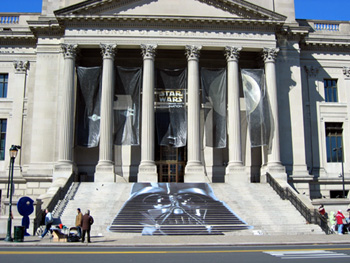
The Gryphon and I had planned to get up nice and early, take our time getting ready, get breakfast and then take the train into the city, but our plans were blown apart when we realized that we had forgotten to move our clocks forward. So we got ready more quickly, had breakfast at the local diner, and drove in.
Surprisingly, even so, we were the first to arrive. I took a picture of the entrance from across the street. The front steps have a painting of Darth Vader, broken up across the different steps. It's best viewed from a distance. Then we picked up our tickets at the Will Call window and waited in the warm sun at the top of the steps while we waited for the others. I joked that, since so many people were taking photos of the front steps, we would automatically become semi-famous.
The first person we saw was The Horror Film Buff's wife, The Seamstress. She waved at us from across the street, and we waved back and came down the steps. According to her, we were waiting for just a few more people. While we waited at the bottom of the steps, I posed for a picture with the metal sculpture there which reminded us of the PBS mascot.
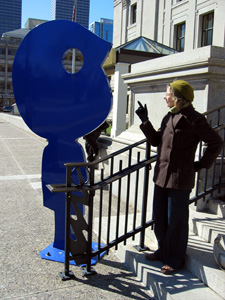
The next person to arrive was another Philcon staffer. We expected one or two others, but The Horror Film Buff called one, and she was still sleeping, having forgotten to reset her clocks. Also, Dr. DJ had said he might come but that he'd call if he was definitely going to be there, and he hadn't.
So we all entered, stopping first in the cloakroom, where I pulled a boneheaded move, accidentally leaving my ticket in the coat so that The Gryphon had to retrieve it for me.
Finally, we got to enter the exhibit, which was in the Mandel Center of the institute. We went at our own pace, sometimes encountering each other at exhibits and discussing them. At the end of the exhibit, we all waited to leave together, because you weren't allowed to reenter.
Despite the fact that we were there opposite a big event, the exhibit was still crowded with families. It was, however, probably less crowded than most of the special exhibitions we've attended at the Philadelphia Museum of Art. There were a lot of hands-on activities, but unlike the rest of the institute, where concepts are illustrated with activities that take just a few seconds, nearly all of the activities took a great deal longer, requiring multiple parts, an instruction sheet, and parental supervision. They all had stools to sit on at work stations, and I didn't feel justified trying to work my way in, with all the families and small children. I did get to see what people were doing, though, and get an idea of the concepts being illustrated.
If you're going to see the Star Wars exhibit at the Franklin Institute and want to try the hands-on activities, you're better off going during the week sometime while kids would be in school. While you're likely to encounter school groups, you won't see as many families with school-age children.
The focus of the exhibit was on the scientific aspect of the series, talking about technological innovations and environmental challenges, since the series presents so many types of ecosystems.
For instance, the first section contained exhibits about hovercars and mag lev trains. Another exhibit near the entrance focused on the extreme cold of the planet Hoth, where conditions are similar to our Antarctic.
Most interesting to me, though, were the displays that showed actual props, models and costumes from the movies, since I'm more interested in the filmmaking process than in scientific concepts. I tried to get photos of the many of them, although sometimes it was hard because you'd have to wait while several other people ahead of you took similar photos.
For example, there were some huge Wookiees from, I believe, the newer movies. I had The Gryphon take a picture of me with them, to get an idea of their enormous size. Even if you take into account the fact that they were mounted about a foot higher inside the cabinet, they're still massive costumes.
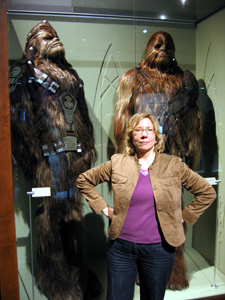
Also in the front section were a model of one of the rebel's Incom T-65 X-wing starfighters as well as Luke Skywalker's T-16 Skyhopper, a beat-up landspeeder.
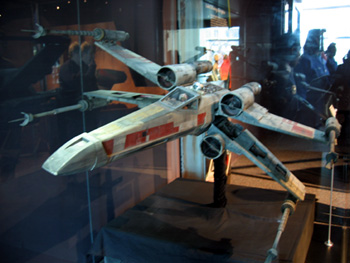
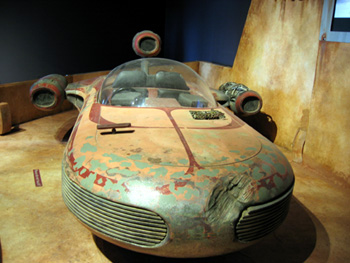
There was a section on robotics, with activities focusing on getting robots to walk. That's apparently a big technological challenge, although there have been some successes in recent years, including a vehicle used in mining operations that functions like a quadruped. Apparently, the advantage is that it doesn't need roads and makes less of an impact on the forest. There, we got to see a model of the All Terrain Armored Transport, or AT-AT walker.
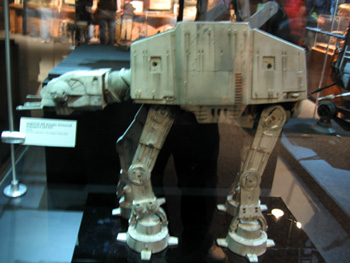
In this section were an R2D2 and C-3PO, but The Seamstress was convinced they were not from the movie, as the originals are in the Smithsonian. Perhaps they were used in the more recent movies.
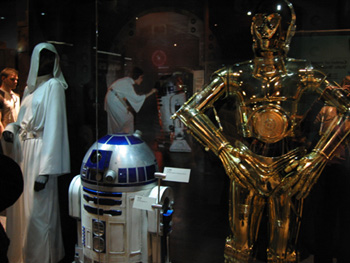
The robotics section also dealt with reproducing human facial expressions through combining eye, eyebrow, and mouth positions. I did get a chance to try out this concept at a computer where you manipulated a computer graphic of a face.
Another display discussed how robots "see," what sorts of light information they can receive and how they recognize faces. Here, we got to see the "naked" C-3PO, from the more recent movies, when he had been built by Anakin Skywalker from scrap pieces and not yet covered with panels to serve as a protocol droid.
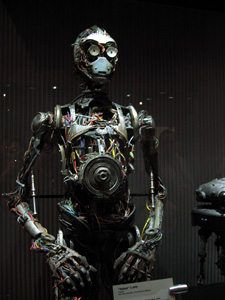
We also saw a battle droid, from the more recent movies.
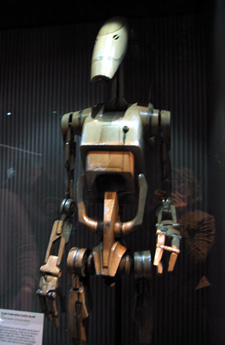
One display talked about the concept of flying cars and the challenges of planning sky routes for such cars. At one computer you could plan such a route.
Nearby was a case containing Yoda. Small he is.
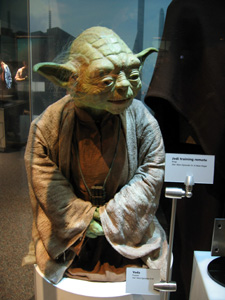
Scattered here and there, some original costumes were on display, such as Chewbacca (although The Seamstress) believed the Han Solo costume next to it was a reproduction. After all, it didn't look 30 years old. While many of these costumes might have been kept in good condition, they might still look a bit faded.

She particularly loved a costume worn by Padme from the more recent movies. This costume she might actually reproduce because she said it would be very comfortable for walking around at conventions.
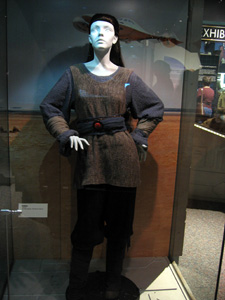
Another section included some of the high-tech light sabers and weapons, although they didn't liken this to modern weaponry technology, probably because they felt that would be a bad focus for children. These props, used in the latest films, looked much more realistic than some of the props from the first three movies, such as some Wookiee weapons that were clearly fake with no moving parts. These light sabers looked like, if you hit the button, they'd work.
I was fascinated by the models of the ships, to get to see the details up close. The ones from Episodes IV through VII, the first movies made, were more intricate. I was intrigued by how they used paint to replicate the appearance of flaking paint and grime. In some cases, a patch looked on camera as if it was down to the primer, when in actuality, it was gray paint daubed on top of the paint job. I think I remember them using a similar technique once on American Chopper to make something look distressed.
The Horror Film Buff pointed out later that the ships didn't look more realistic because a series of lights were used while shooting to light up portions of the inside. It also didn't help that the display case lighting was very flat. Still, I got to see the Millennium Falcon and a TIE fighter.
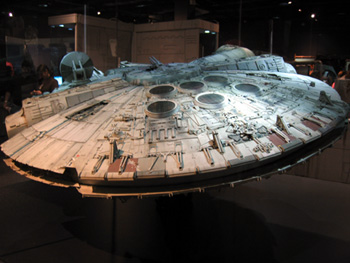
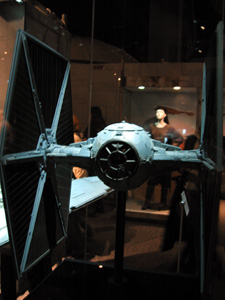
The models for the earlier films were very detailed and fully painted, whereas the models for the recent films were just gray concept models. While in the original films, the models were used to make the final image, the concept models are simply scanned into a computer for CGI.
The final portion of the exhibit concentrated on high-tech prosthetics, which was where we got to see both Darth Vader's special suit as well as the protective gear of a Storm Trooper.
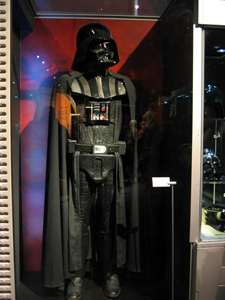
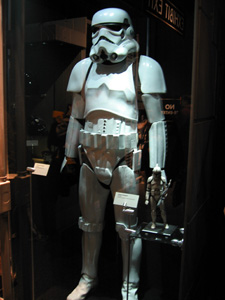
Again, The Seamstress was convinced the Darth Vader costume was newer, and it did seem to show some detail that I only remember seeing in the more recent films.
The display on prosthetics was interesting; how they're using computer chips to interact with the human neural system. One part of the cabinet dealt with prosthetics that interact with the brain, such as one that allowed a quadriplegic to complete simple tasks through a computer, a prototype for restoring vision to the blind, and of course, the cochlear implant for the deaf.
When we were all ready to leave, we checked out the gift store. Aside from some amusing bobble head dolls, there was nothing that appealed to us. We headed instead for the main gift store downstairs, which had a wider display of books, where The Seamstress found a book on the making of Star Wars which she hopes will be useful in making costumes.
I didn't find anything of interest in the Star Wars section but found a book called Philly Dogs Have More Fun by Carol S. Armen, which lists dog-friendly activities, restaurants, parks and attractions in the Philadelphia area. Maybe we'll try some this summer.
We headed for the cafeteria for a bite to eat. I was just a little peckish, so I had a garden salad with light dressing and a bottle of water. I'd had a nagging, mild headache all day, possibly related to the weather, and The Seamstress gave me some Advil.
Next, we all went to the planetarium show, a special presentation related to the Star Wars movies. While there was a line at the door, everyone got in with no problems. And all seats in there are equally good.
That show was disappointing, as it didn't contain any information that hadn't been discussed in the exhibit. Still, you got to see some pretty pictures of planets. The voice of the narrator was so slow and modulated that it put me to sleep, and I had to fight to pay attention.
We parted ways after the planetarium show, but The Gryphon and I stayed a bit longer. He had a meeting of PAGE (Philadelphia Area Gaming Enthusiasts) that night, and we planned to have dinner and then I would drop him off.
First, we visited the closest exhibition hall, which had hands-on exhibits about trains. It was nice not to have to wait behind large groups of families. We had some trouble with one that involved completing a circuit and getting a needle to move to the left, until a teenage boy showed us how, saying that you had to press down hard on two specific metal plates.
We walked through the train on display there and then moved to the section on the human body, with the famous giant heart.
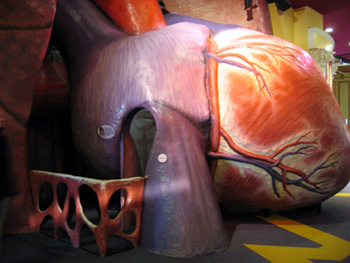
The last time I'd gone through it, I remember thinking it was really cramped. That was when I was just at the beginning of my weight loss. This time, it didn't feel cramped at all.
My favorite exhibit in the body section was a scale that showed you how much blood was in your body. You stepped on a scale, and red water would pour into tubes, until they settled at a certain level. In my case, I contained nearly 20 cups of blood, while The Gryphon contained nearly 30.
I also loved a new video I hadn't seen. They had a large TV with a video you could start with a button. It played a song by They Might Be Giants called "The Bloodmobile," which explained the function of the bloodstream.
We were running out of time, so we stopped in the Franklin Gallery to check out the exhibits based on his scientific experiments. Some of them were in need of maintenance. In particular, some exhibits which required water needed to be refilled. I suppose even though the containers are sealed, there is some water loss over time.
The electricity exhibit was functioning, much to our delight. Here's The Gryphon with the large glass tube where you can press a button and watch an electrical current shooting up inside.
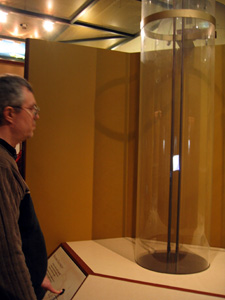
They had a few new things, such as a computerized activity based on Poor Richard's Almanac, where you dragged words into a saying to create your own. It then printed them out for you, in case you wanted a keepsake.
By that point, we only had about five minutes before the museum would close, so we headed out. On the way, I got a couple shots of the famous memorial statue to Ben Franklin in the entry way.
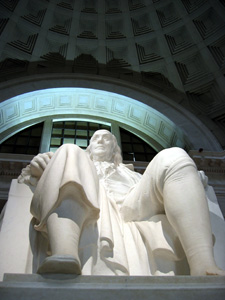
I had picked up a guide to local restaurants from the info desk. We considered going to an Irish place and then thought better of it when we remembered the St. Patrick's Day parade. Then we headed for a Southwestern place, the Mission Grill, but they weren't open yet for dinner, even though it was nearly 5.
We kept walking and ended up at the Mexican Post. Several times, we've eaten at the Mexican Post in Old City, which I knew about from when I used to work at a Museum in the area. My coworkers used to go there after work for margaritas, but I rarely joined them, since I had to get back to my doggie, Una.
There were a few people at the bar and almost no one in the restaurant. I ordered a veggie burrito, served with Spanish rice and refried beans. It was tasty. The veggies were grilled just to the point where they were soft enough, without losing the freshness.
The decor featured the bright colors you might expect from a Mexican restaurant, but some of the architectural features, such as a large cement pillar in the middle of the floor, clearly looked more like a modern office building.
Afterwards, we returned to our parking garage. Just as I was reminding him to ask The Dormouse to tell him about the end of the Confed adventure, we saw The Dormouse pulling into another parking garage. We decided not to wait for him, since The Gryphon would be late and he was running a game. I dropped him at his meeting, then went home and got a little work done. You know me; I'm happiest on the days where I both play and work.
I am indebted to the excellent site StarWars.com for the information on vehicles and starships.
Moral:
CGI means fewer cool miniatures to photograph.
